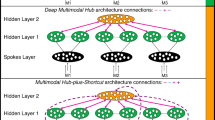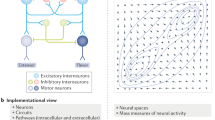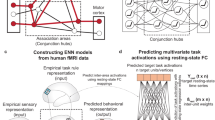Abstract
A fundamental issue in the study of cognition and the brain is the nature of mental computation. How far does this depend on internally represented systems of rules, expressed as strings of symbols with a syntax, as opposed to more distributed neural systems, operating subsymbolically and without syntax? The mental representation of the regular and irregular past tense of the English verb has become a crucial test case for this debate. Single-mechanism approaches argue that current multilayer connectionist networks can account for the learning and representation both of regular and of irregular forms1,2. Dual-mechanism approaches, although accepting connectionist accounts for the irregular forms, argue that a symbolic, rule-based system is required to explain the properties of the regular past tense and, by extension, the properties of language and cognition in general3,4,5. We show here that the regular and irregular past tense are supported by different neural systems, which can become dissociated by damage to the brain6,7. This is evidence for functional and neurological distinctions in the types of mental computation that support these different aspects of linguistic and cognitive performance.
This is a preview of subscription content, access via your institution
Access options
Subscribe to this journal
Receive 51 print issues and online access
$199.00 per year
only $3.90 per issue
Buy this article
- Purchase on Springer Link
- Instant access to full article PDF
Prices may be subject to local taxes which are calculated during checkout

Similar content being viewed by others
References
Rumelhart, D. E. & McClelland, J. L. in Parallel Distributed Processing: Explorations in the Microstructure of Cognition Vol. 2(eds McClelland, J. L. & Rumelhart, D. E.) 216–271 (MIT Press, Cambridge, MA, (1986)).
Plunkett, K. & Marchman, V. From rote learning to system building: acquiring verb morphology in children and connectionist nets. Cognition 48, 21–69 (1993).
Pinker, S. Rules of language. Science 253, 530–535 (1991).
Pinker, S. & Prince, A. On language and connectionism: analysis of a parallel distributed model of language acquisition. Cognition 28, 73–193 (1988).
Prasada, S. & Pinker, S. Generalisation of regular and irregular morphological patterns. Lang. Cogn. Processes 8, 1–56 (1993).
Shallice, T. From Neuropyschology to Mental Structure (Cambridge Univ. Press, (1988)).
Teuber, H.-L. Physiological psychology. Annu. Rev. Physiol. 9, 267–296 (1955).
Tyler, L. K. Spoken Language Comphension (MIT Press, Cambridge, MA, (1992)).
Ostrin, R. & Tyler, L. K. Dissociations of lexical function: semantics, syntax and morphology. Cogn. Neuropsychol. 12, 345–389 (1995).
Tyler, L. K., Ostrin, R. K., Cooke, M. & Moss, H. E. Automatic access of lexical information in Broca's aphasia: against the automaticity hypothesis. Brain Lang. 48, 131–162 (1995).
Funnell, E. Morphological errors in acquired dyslexia: a case of mistaken identity. Q. J. Exp. Psychol. 39A, 497–539 (1987).
Patterson, K. & Marcel, A. Q. Aphasia, dyslexia and the phonological coding of written words. J. Exp. Psychol. 29, 307–318 (1977).
Tyler, L. K. & Ostrin, R. The processing of simple and complex words in an agrammatic patient: evidence from priming. Neuropsychologia 32, 1001–1013 (1994).
Goodglass, H. & Kaplan, E. The Assessment of Aphasia and Related Disorders2nd edn (Lea & Febinger, Philadelphia, (1982)).
Kay, J., Lesser, R. & Coltheart, M. The Psycholinguistic Assessment of Language in Aphasia (Lawrence Erlbaum Associates, Hove, (1992)).
Black, M., Nickels, L. & Byng, S. Patterns of sentence processing deficit: processing simple sentences can be a complex matter. J. Neuroling. 6, 79–101 (1991).
Linebarger, M., Schwartz, M. & Saffran, E. Sensitivity to grammatical structure in so-called agrammatic aphasics. Cognition 13, 361–392 (1983).
Acknowledgements
We thank M. Cooke, Y. Griffiths,F. Jennings, J. Morris and K. Voice fortheir assistance with the studies reported here and R. Wise andthe Wellcome Department of Cognitive Neurology for the MRI scan ofD.E. This research was supported by the MRC and theESRC.
Author information
Authors and Affiliations
Rights and permissions
About this article
Cite this article
Marslen-Wilson, W., Tyler, L. Dissociating types of mental computation. Nature 387, 592–594 (1997). https://doi.org/10.1038/42456
Received:
Accepted:
Issue Date:
DOI: https://doi.org/10.1038/42456
This article is cited by
-
A discriminative information-theoretical analysis of the regularity gradient in inflectional morphology
Morphology (2023)
-
Sensitivity to Inflectional Morphemes in the Absence of Meaning: Evidence from a Novel Task
Journal of Psycholinguistic Research (2019)
-
Computational Models of the Representation of Bangla Compound Words in the Mental Lexicon
Journal of Psycholinguistic Research (2016)
-
Computational Modeling of Morphological Effects in Bangla Visual Word Recognition
Journal of Psycholinguistic Research (2015)
-
Grey Matter Volume in the Cerebellum is Related to the Processing of Grammatical Rules in a Second Language: A Structural Voxel-based Morphometry Study
The Cerebellum (2014)
Comments
By submitting a comment you agree to abide by our Terms and Community Guidelines. If you find something abusive or that does not comply with our terms or guidelines please flag it as inappropriate.



